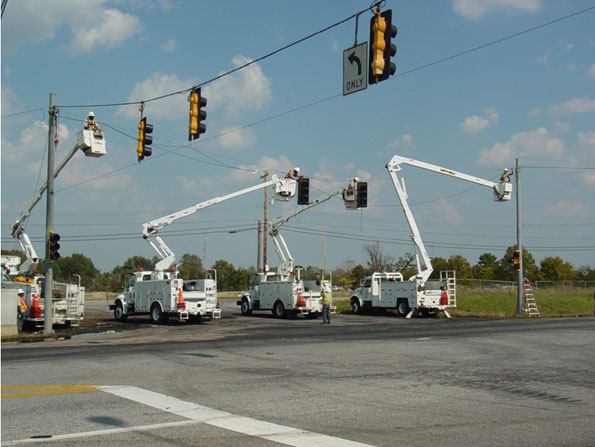TTAP Newsletter: RoadTalk
SPOTLIGHT – CITY OF MEMPHIS Traffic Signal Maintenance and Construction
by Dr. Airton Kohls

I was in Memphis in the beginning of February to present CTR’s Traffic Signal Academy and I was impressed with the practices of the City of Memphis’s Traffic Signal Maintenance Department. The agency prioritizes the safety of pedestrians, bicycle users, motorists and the efficient movement of goods throughout the city by maintaining existing traffic signals and installing new signals with a high degree of excellence. The agency is responsible for an impressive 830 city-owned traffic signal and flasher controlled intersections, 140 city-owned school flashers, 230 jurisdiction-owned traffic signal and flasher controlled intersections, and 104 jurisdiction-owned school flashers.
Let me give you some facts regarding the City of Memphis's traffic signal maintenance and construction operations. It is a 24 hours per day, 7 days per week, 365 days per year operation with 3 shifts: 7am-3pm (day shift), 3pm-11pm (evening shift), and 11pm-7am (night shift). The day shift normally runs two crews responsible for planned (preventive) maintenance and inspection of school flashers and flashing intersections. The evening shift has a minimum of two crews scheduled for limited planned maintenance and special projects like LED installation. The night shift also has a minimum of two crews assigned to special projects and maintenance/inspection duties.

Their personnel consists of a manager, 18 signal technicians, 11 signal aides, a procurement specialist, a general clerk, and a day shift dispatcher. Evening, midnight and weekend dispatch is handled by the Emergency Management Agency. There is also a construction crew of 7 to 9 workers overseen by the construction crew lead technician and an inspector. The construction crew also serves as backup for maintenance activities. The electronics lab has a 3 member team during the day shift. Their responsibilities are to maintain the computerized traffic signal system/database ACTRA, maintain the school flasher database, repair fiber optic cables, repair all electronic equipment relevant to the traffic signal system (even controllers and conflict monitors), build new cabinets, perform inspections of new/modified intersections and assist other bureaus with electronic/electric problems.
The Traffic Signal Maintenance department is well equipped with nine single-man and two two-man bucket trucks, two pole trucks with trailer, one dump truck, two stake bed trucks (one with loop saw), one trenching tractor, one mini skid steer loader, support vehicles and two air compressors with jackhammer equipment. The agency also has an eight-vehicle heated garage, a pole storage lot and onsite fuel tanks.

Some of the agency's highlights thru the years include extensive repairs to over 470 intersections that suffered wind damage in 2003, installation of LED lights at 100% of the city's signalized intersections, and continuous repairs to equipment due to crashes. One additional comment from the agency that was interesting to me was that it is estimated to take 18 months to train a new technician before he can perform duties on his own. During the classes, I observed how the interaction between the agency’s engineers, managers, and technicians allowed them to exchange ideas and adopt a proactive approach to traffic signal management and maintenance, a constructive practice that I always preach in the Traffic Signal Academy. For additional information, please contact Mr. Jay Walko at 901-528-2844.

Back-Contents-Forward
